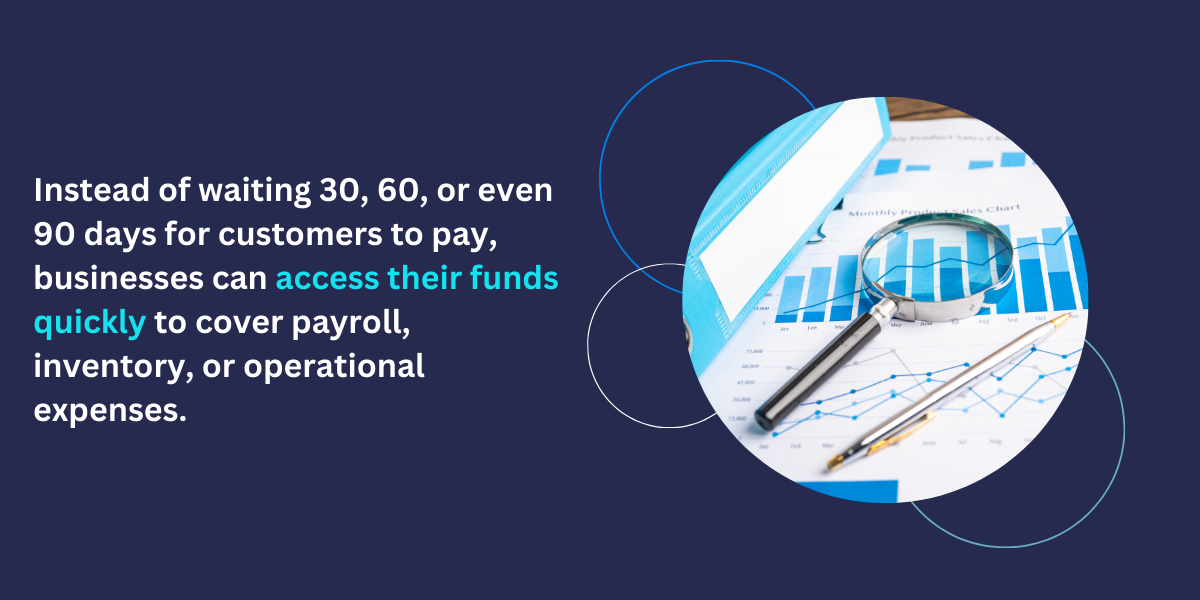Unpaid invoices are a problem for businesses. According to recent survey data, 73% of SMBs experienced problems with late payments, and 40% said continued delays could force them to close their business in the next year.
It makes sense: If invoices aren’t paid on time and in full, cash flow becomes a problem. In addition, staff need to spend time and effort contacting customers with outstanding invoices and asking them to pay ASAP. The result is an operational shift — instead of cultivating customer relationships and increasing sales, companies must focus on collections.
Invoice factoring offers an alternative.
What Is Invoice Factoring (and How Does It Work)?
Also known as accounts receivable factoring, spot factoring, or invoice discounting, invoice factoring is the practice of selling some (or all) of your outstanding invoices to a third-party provider. You provide your invoice as usual to customers and send a copy to your factoring provider. Customers then pay the factoring company directly.
Your provider gives you a cash advance on each unpaid invoice balance and takes on the responsibility of collecting the full amount of your invoice. Providers typically offer advances between 80% and 95% of the total invoice value, depending on the current financial state of your company and the creditworthiness of your invoiced clients. Invoice factoring providers charge a fee for this service, which is typically assessed per month.
Using invoice factoring, businesses can ensure consistent cash flow without the need to take out a small business loan.
The caveat? It’s critical to understand the total costs of factoring and the role of a reputable provider in delivering consistent invoice factoring services that don’t break the bank.
Get started here: Learn more about invoice factoring.
Understanding the Cost of Invoice Factoring
Two costs are common in factoring agreements: Interest rates and service fees.
Also called factoring rates, interest rates typically range from 1% to 5% of the total invoice value per month. This means that if you have a $10,000 invoice and the interest rate is 2%, the factoring company keeps $200 when the invoice is paid.
Service fees, meanwhile, may include minimum monthly fees, maintenance fees, and early termination fees, depending on the nature of your agreement with the factoring provider.
Here’s a quick example of factoring costs:
- Your business sells an invoice of $50,000 to a factoring provider
- The provider’s flat invoice factoring fee is 3% per month, plus an additional 0.5% in service fees, or 3.5% per month
- The provider offers a 90% cash advance with the remainder due when the invoice is paid.
This means you get $50,000 x 0.90 or $45,000 in a cash advance.
If the invoice is paid in the first 30 days, the provider takes 3.5% of the remaining balance, which works out to $5,000 x 0.035, or $175. Your business receives the remaining balance of $4,825.
It’s worth noting that service and interest fees are typically charged per month. This means that if clients take 60 days to pay their invoice instead of 30, you pay twice as much, or $350, and receive the remaining balance of $4,650.
Factoring fees also differ based on the amount of your invoice, the creditworthiness of your customer, and the type of factoring agreement you have — recourse or non-recourse.
For example, the interest rate for a $500,000 invoice may be 4% or 5%, while the rate for a $50,000 may be half that. This is because the advance cash amount is significantly higher in the first case than the second — $450,000 vs. $45,000 for a 95% advance — which means greater financial risk for the factoring company if the invoice is not paid.
Recourse vs. Non-Recourse Factoring
Factoring agreements are either recourse or non-recourse.
In a recourse agreement, your business is responsible for covering the cost of an invoice if the customer refuses to pay. Provider contracts will specify when recourse applies — for example, after a certain period or after a specific number of attempts to contact customers and negotiate payment terms.
In a non-recourse agreement, the provider assumes all liability for invoices. This means that if invoices aren’t paid or customers refuse to return calls, the provider absorbs the cost of the lost payment.
Not surprisingly, non-recourse agreements are more expensive than recourse agreements. Consider the $500,000 invoice example above. In a recourse agreement, if customers fail to pay the factoring company within the agreed-upon timeline, the invoice defaults back to your company. You are then responsible for collecting the money and paying back the cash advance from your factoring provider.
In a non-recourse agreement, the factoring company accepts the $450,000 loss if customers do not pay. While credit checks and historical payment data can help lower the risk of non-payment, factoring companies charge significantly more for non-recourse factoring to offset the potential loss.
Comparing Invoice Factoring to Other Financing Options
Along with invoicing factoring, there are other options to help finance your business. Common examples include business loans, lines of credit, and what’s known as invoice financing. Here’s a look at each in more detail.
Business loans
Business loans are issued by banks or other financial institutions. Your business applies for a loan based on needed capital and operational expenses, and the bank approves or denies the loan.
For example, if you have $1,000,000 in completed unpaid invoices, the bank might lend your business $700,000 or $800,000 at a fixed interest rate over a set term. While this provides immediate access to cash, it also means you’re on the hook for repayment — even if you can’t collect outstanding invoices.
Lines of credit
Credit lines are similar to loans. The difference is that instead of a lump sum up-front, you draw from a maximum credit amount, which you must then pay back.
Consider a $100,000 line of credit. You can draw all of this amount immediately or only draw as much as you need to stay operational. You must pay back whatever you draw. In addition, most lines of credit have a specified draw period, followed by a repayment period. This means that you can only draw from the credit line for a set amount of time, such as one or two years. After the draw period has passed, you must pay back the full amount, plus interest.
While a credit line offers more control over the amount you borrow, you’re still responsible for ensuring invoices are paid and repaying the loan.
Invoice financing
In the case of invoice finance services, you borrow money from a financing company against the balance of your outstanding accounts receivable. When your customers pay their invoices, you use this money to pay back your invoice financing company, plus any applicable fees and interest.
Like invoice factoring, this approach provides immediate cash flow access. Unlike factoring, however, invoice financing is a loan based on your outstanding invoice amount. The longer you take to pay back the loan, the more expensive it becomes.
Key Qualities to Look for in a Factoring Company
When searching for a factoring company or evaluating your current partner, consider the following key factors:
- Experience and Reputation
Look for a factoring company with a strong track record in the industry. Established companies have refined processes, proven reliability, and a reputation for excellent service. Consider financial companies that have been in business for several years and have strong reviews. - Industry Expertise
Different industries have unique cash flow challenges. Choose a factoring company that understands your industry’s nuances. Whether you’re in manufacturing, staffing or wholesale distribution, a company that understands your business can provide tailored solutions. - Transparent Fees
Factoring fees can vary widely. Some companies charge hidden fees that erode the value of your funding. Look for transparency in fee structures, including discount rates and additional costs. Look for a company that prides itself on straightforward pricing, ensuring you know exactly what you’re paying for. - Flexible Terms
Your business needs may change over time. A good factoring company offers flexible terms that adapt to your needs. This includes flexible contract terms, funding limits and the ability to factor all your invoices or to be selective. - Speed of Funding
Time is money–especially when you’re managing cash flow. Look for a factoring company that offers quick turnaround times. Ask about he turnaround time from paperwork approved to receipt of funds. - Customer Support
A strong relationship with your factoring company is crucial. Dedicated account managers and responsive customer support ensure a seamless experience. Ask how long your account manager has been with the company and how many years of experience they have in factoring.
How Factoring Companies Work
Understanding the process can help you identify the right partner. Here’s a step-by-step look at how factoring companies operate:
- Application and Approval
Submit your application and the necessary documentation. The factoring company will evaluate your customers’ creditworthiness to determine your eligibility. - Submit Invoices
Once approved, you send your unpaid invoices to the factoring company. - Receive Funding
The factoring company advances a percentage of the invoice value (typically 80–90%) to your account, often within 24 hours. - Customer Payment
Your customer pays the invoice directly to the factoring company according to the agreed payment terms. - Receive Remaining Funds
After deducting the factoring fee, the remaining balance is transferred to you.
Key Questions to Ask a Factoring Company
To ensure you’re choosing the right partner, ask these essential questions:
- What are your rates and fees? Are there any hidden charges?
- How quickly can you provide funding?
- What industries do you specialize in?
- Can you provide references or case studies?
- What is your process for managing customer payments?
Invoice factoring is more than just a financial solution; it’s a lifeline for businesses facing cash flow challenges. By partnering with a reliable factoring company like Porter Capital, you can unlock the potential of your business while ensuring financial stability. Whether you’re in manufacturing, staffing, or distribution, we’re here to support your growth and success.
Invoice Factoring with Porter Capital
At Porter Capital, our clients are more than just numbers. We provide personalized attention with dedicated account executives who understand your business. We also know that time is critical. Our daily credit committee meetings enable us to approve clients and provide funding within as little as 24 hours. Whether you need $25,000 or $25 million, Porter Capital offers scalable solutions to meet your needs.
If you’re looking for a factoring company that prioritizes your business’s success, look no further than Porter Capital. With over three decades of experience, transparent pricing, and flexible funding options, we’re here to help you achieve your financial goals. Call us at 1-888-865-7678 for more information or reach out online to request your free, personalized proposal.




